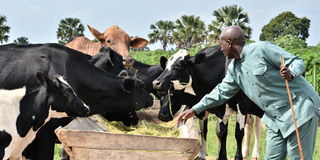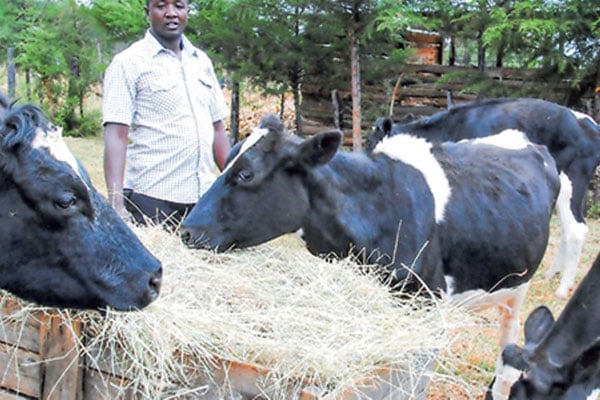Prime
Plant fodder to boost your farm production

Stephen Muvunyi feeds his Friesian cows with silage. Photos / George Katongole
What you need to know:
- lack of adequate and high quality feed is a major constraint to dairy cattle production particularly on smallholder farms in dry periods
Stephen Muvunyi has been a pastoral farmer for more than 50 years. After dropping out of school to take care of his father’s cows, he knows the only way out of poverty is to rear cows diligently.
Muvunyi, who has a 300-acre farm in Nyakarongo village in Kinoni Sub-county, Nakaseke District has been depending on land since he was born. He rears cows and now identifies himself as a pasture farmer.
Muvunyi started cattle keeping while he was a boy on his father’s farm in Sembabule District before he became a farmer in his own right at the age of 12. “When I was 12 years, my father gave me a kraal to take care of and when he died in 1979 when I was 19, I kept the family tradition of keeping the long-horned Ankole cattle,” Muvunyi says.
In 1997, he gave up on keeping local breeds due to their low milk productivity and stocked improved breeds. He started with two Friesian cows and when he got a combined 35 litres from them every day, he did not look back. Today, he proudly owns 100 heads of cattle, 70 of them Boran crosses and 30 Friesians. Despite their high milk production, the Friesians were not as resistant to vagaries of weather and diseases as the long-horned cattle, locally known as Inyambo.
Whereas he is rooted in the pastoralists’ lineage, whose life depends on moving to even far areas in search of greener pastures and water, Muvunyi was aware the Friesians were not bred for those long distances.
With irreversible climatic changes, Muvunyi now faces the biggest enemy of cattle keepers in the cattle corridor – lack of water and pasture.
The dangers
Between November and April, most parts in the cattle corridor undergo a dry season. Seasonal rivers that earlier flooded the low-lying areas dry off and grass turns to gold.
The “cattle corridor” of Uganda is one of the hardest hit areas due to the impacts of climate change and variability.
The cattle corridor is a semi-arid ecosystem that covers 40 percent of Uganda’s land and is characterised by scanty, unreliable rainfall ranging between 450–800mm per year. It is subject to recurrent droughts and has sparse vegetation.

Stephen Muvunyi feeds his Friesian cows with silage. photos / george katongole
The scarcity of water resources for human and livestock consumption in the cattle corridor has been linked to increased temperatures, seasonal shifts, reduced rainfall, and lower water quality through siltation.
Muvunyi, who has two reservoirs says that the water stays in the dams for at least two months before it dries up while they have to find alternatives in the remaining months before the rains. When the rain delays, the consequences are dire.
When the dams dry, Muvunyi says they have to buy water from trucks. Each truck-full of water goes for Shs500,000 yet with an average of 20 litres per cow, a truck serves just one day.
“For two months, if you are buying water that means spending millions of money. Some of the cows die off while others abort,” says Muvunyi.
This situation causes animals to be sold for any price while others starve to death for lack of pasture and water. Muvunyi recalls losing some cows in the previous years. Without permanent water sources, many farmers count even bigger losses.
Grow your fodder
Yet lack of adequate and high quality feed is a major constraint to dairy cattle production particularly on smallholder farms in dry periods.

A newly established alfalfa grass garden.
In Nakaseke, where the prolonged dry season can last up to five months, experts explain that during that period cattle can only be sustained on conserved forage and fodder from the high yields produced during the rainy season, when there is often an excess. Conservation can be through tube silage technology which is appropriate for the smallholder dairy farmers.
The prolonged drought has affected farmers such as Muvunyi.
Muvunyi is a lead farmer of Heifer International’s Accelerate Dairy Production and Productivity (ADAP), a Shs3.66b farmer-based project aimed at adopting a holistic approach for a sustainable dairy sector.
After successful introduction of pasture, valley tanks will be constructed by the project to supply water for both domestic consumption and livestock production particularly during the dry season.
Through the two-year project which started in December 2020, Heifer International aims at ending poverty by empowering farmers to earn a living income through increased production and productivity.
The project was implemented in six districts including: Nakasongola, Luweero, Nakaseke, Kiboga, Mubende and Sembabule. But it was a challenging start as many farmers in the area had negative perceptions towards growing pasture.
After training farmers, they were taken to farm visits to exchange ideas with other farmers that were growing pasture.
Muvunyi is among those that were not initially convinced when he was approached by Heifer international’s field staff.
“How can one grow weed?” he wondered. As a result, even though he grudgingly accepted to give the idea a try, many others who had similar perceptions stayed put. Only five farmers would accept the seeds that were offered as a motivation.
Muvunyi has planted seven acres of pasture including protein-rich Nutrifeed, sugargraze, which is a major source of carbohydrates, Chloris Guyana, a species of grass harvested to make silage and alfalfa.
Alex Kabale Luggya, a community-based facilitator says that the consistent dry periods have been a blessing in disguise.
Luggya says that once small-scale farmers understand the value of silage, there is no turning back and you do not need expensive equipment to make it.

Workers prepare the mixture of Nurtifeed and Sugargraze for ensiling. Muvunyi employs about 50 people on his farm in Nakaseke.
“This was an eye opener to the farmers to prove that the technology they learnt in other places has been working. Through our model farmers, the community members have come to realise that one can have something to feed their cows during even the dry spells,” he says. Although pasture grows pretty fast, the costs of growing fodder are high. Luggya explains that most of the varieties are ready to be harvested after five weeks.
The pasture farm must be fenced away from stray animals while ploughing large chunks of land requires tractors.
In Nakaseke, both present even bigger challenges to the farmers. A tractor, for instance, is acquired for at least Shs250,000 to work on an acre.
“Farmers need to look at the big picture because growing pasture is the new normal. Extension workers need to help farmers to maximise the opportunities of growing pasture by choosing the right crops, preparation of the soil, taking care of the crops and how to cut or use it,” Kabale says.
Farmer-led groups key
To solve most of the challenges, the solution lies in working together as farmers’ groups.
In Kinoni, the willingness of farmers to work together is striking. From large to smaller groups, being open to neighbours seems to come easily. But that was not the case at least before the coronavirus pandemic.
More than 500 farmers are part of the four cooperatives that have been formed in the Sub-county to increase productivity.
James Nuwagaba, the chairman of Nyakarongo Dairy Farmers Cooperative Society, which started in May 2021, says they realised that working together was the only way to get bargaining power.
“We were being cheated by the middlemen who used to buy milk for as low as Shs300 per litre during the rainy season. But when we formed the cooperative, we now sell milk for as high as Sh800,” Nuwagaba says.




